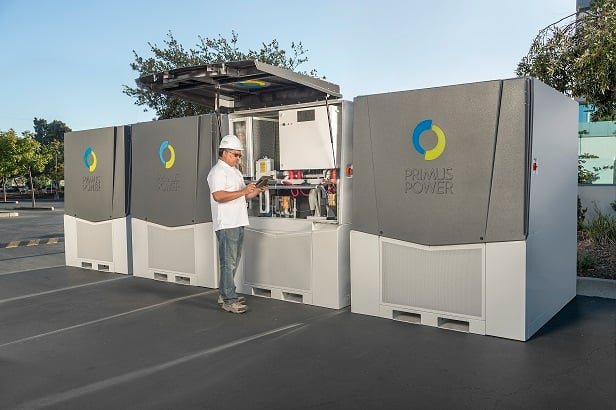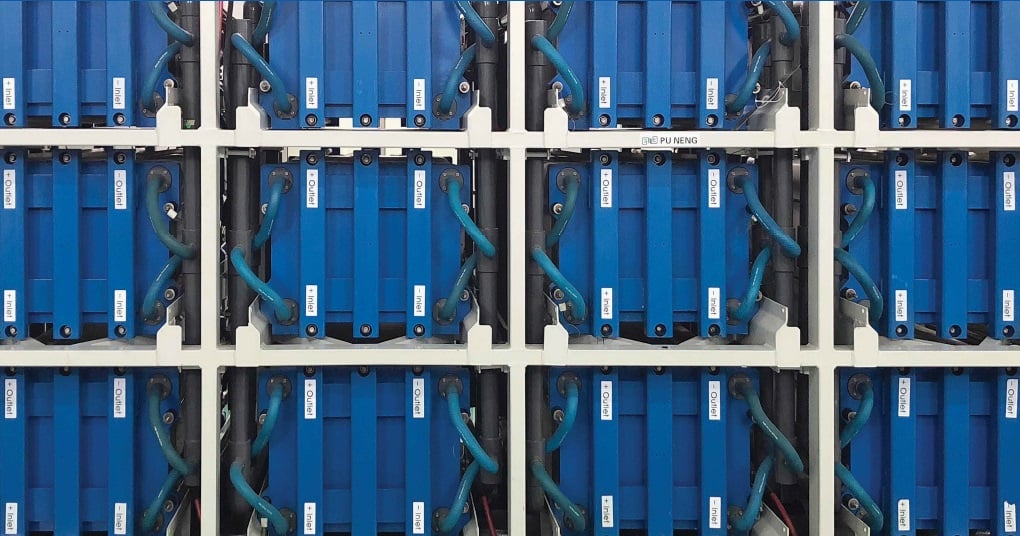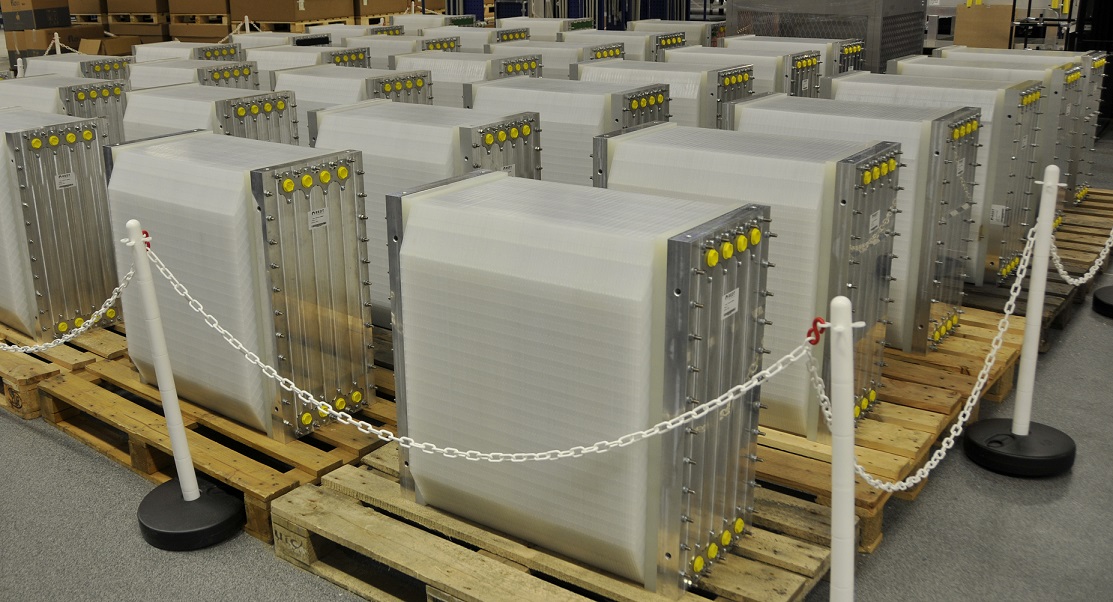
First developed by NASA, flow batteries are a potential answer to storing solar – and wind – for eight to 10 hours, far beyond what is commonly achieved today with lithium-ion. In the first of a two-part special report, Andy Colthorpe learns what the flow battery industry faces in the fight for commercialisation.
Solar is easy to explain. Sunlight hits panels, electricity hits grid. Then come the inevitable questions about using power when the sun doesn’t hit the panels, about batteries and the well-rehearsed explanation comes that yes, while it would be great to use solar power 24/7, we’re just not there yet with the cost of technologies as they are, for the most part.
Enjoy 12 months of exclusive analysis
- Regular insight and analysis of the industry’s biggest developments
- In-depth interviews with the industry’s leading figures
- Annual digital subscription to the PV Tech Power journal
- Discounts on Solar Media’s portfolio of events, in-person and virtual
So the more complex explanation follows that lithium batteries are being deployed at large-scale to store energy for short periods of time, to deliver frequency regulation, or to remove specific hours of a peak demand period. A market need for long-duration storage remains elusive outside of specific circumstances such as remote grids where batteries and PV are replacing expensive diesel. Providers of flow batteries would beg to differ.
While acknowledging that lithium’s head start from a mass production perspective and other factors contribute to a higher capex overall for flow, flow energy storage providers are quick to point out the long lifetimes of their machines, the low cost of their raw materials, the comparative lack of fire hazard and associated balance-of-system costs and sheer ability to store huge amounts of energy, rather than power, mean flow could be the cost-effective long-duration choice of the renewables industry.
“People used to ask us what we needed the fifth hour for and now they ask if we can go to 10 hours,” Jorg Heinemann, chief commercial officer at Primus Power says.
Heinemann joined zinc bromine stationary energy storage maker Primus Power after eight years developing utility-scale PV with SunPower, believing long-duration storage to be the natural next step for renewable energy. Customers that have large amounts of solar PV are now approaching Primus with the intent to use solar-plus-storage as peaker replacements and to use behind-the-meter battery assets to offset transmission and distribution (T&D) investment costs.
“That’s beyond four hours [of storage], that means putting in a request for five, six or even eight hours, to take renewable power and add it to the storage and you’ve eliminated the need for a peaker. That last wave of use cases, T&D deferral, gas peaker replacement, heavy duty renewable extension,those are new, at least new to us. People have talked about them in theory, we’re now getting those active requests.
In California, where Primus is headquartered, lithium batteries have now been deployed to provide capacity in the wake of natural gas plant retirements and questions over security of supply following the Aliso Canyon gas leak, marking a milestone for batteries to be used on the grid for more than short-term balancing services. The state’s main investor-owned utilities now also have to include consideration of four-hour duration energy storage in their Resource Adequacy Plans. Other parts of the world are moving there faster, with various dispatchable solar projects announced in recent months.
Flow energy storage, which can use a variety of chemistries including vanadium, zinc bromine and in one instance, iron for the electrolyte, puts a central battery stack between electrolyte in tanks. As Navigant Research analyst Ian McClenny points out, the levelised cost of energy decreases as discharge duration increases. In other words: scale up the tank size, scale up the project’s energy need (as opposed to power), bring down the cost.
“The cost over the lifetime of the storage asset is heavily dependent on what type of applications the device will be serving,” McClenny adds, and although the capex required for flow might be higher than lithium, flow battery makers would argue that that initial cost is outweighed in the long run by the other benefits of ruggedness and long lifetime that they claim.
Navigant also sees flow energy storage as a four-hour+ duration storage device and the firm has identified flow batteries as one of the clean and distributed energy technologies expected to grow fastest in the next 10 years in terms of market share.
McClenny says at present the majority of advanced energy storage being deployed around the world is still providing services that require less than four hours’ duration.
“Consequently, Li-ion batteries can provide the same services that flow can at a lower capex,” within the context of most current global markets, McClenny says.
More duration, more dispatchable power
However, as Primus Power’s Jorg Heinemann argues, the planet is “heading toward close to free power during daylight hours” and the “base case that will eventually run the planet is to take renewable electricity, store it with long duration storage and dispatch it in the evening, night-time and early morning hours when the sun is not shining”.
Prices are falling and many utility-scale PV plants that are 10 years old today will be producing power almost for free in another 20 years, Heinemann cites as an indicator. “Now the typical solar developer or independent power producer is recognising energy storage as a very doable and economic thing, and a good value proposition.”
Jim Stover, business development VP at Pu Neng, soon to be rebranded VRB Energy in markets outside China, points out that that country’s renewable energy sector is about to put wheels in motion that could make flow unstoppable. Pu Neng, now US- and Canada-headquartered VRB’s subsidiary, is among the vanadium flow battery makers to be in the running for projects in China that will provide multiple hundreds of megawatt-hours of storage to local grids. China’s government set out its official stance on energy storage for the first time ever in October 2017 when it issued “Guiding Opinions on Promoting Energy Storage Technology and Industry Development”, the policy which informed the mammoth decision.
Already awarded is a contract for Rongke Power, which has a well-known subsidiary in the US, UniEnergy Technologies (UET), to install a 200MW/800MWh flow battery system in Dalian Province, with the company itself having emerged from the Dalian Institute of Chemical Physics originally.
The China National Energy Administration approved that project and is considering developers for a further 100MW / 500MWh system – for which Pu Neng is installing a 3MW / 12MWh demonstration project – and two further, reportedly 1GWh projects paired with wind energy and a nuclear plant. This would massively skew megawatt-hour deployment figures worldwide in flow’s favour, although the projects themselves are unlikely to be connected for at least another 10 years.
“The Chinese government I think in particular is happy to incentivise or call out vanadium like this. They want to push a number of technologies, but there is an awful lot of vanadium resources in China, both from mine sites and from steel slag recovery,” Jim Stover says.
“They’re trying to seize that as a good and natural fit, they don’t have a lot of lithium. They have a lot of lithium manufacturers but not a lot of lithium itself, or cobalt, or nickel even. That’s one of the dynamics in China.”
Big batteries, long durations, and (mostly) huge amounts of renewables enabled; the signs seem positive. Nonetheless, we have seen the likes of VIZN and Imergy hit the scene with numerous deployments and promising low cost storage, only to succumb to bankruptcy and layoffs. As Navigant’s Ian McClenny says, despite flow being his team’s forecasted “fastest growing electrochemical energy storage device over the next 10 years”, there are still “short term hurdles”.

Education and cost-competitiveness
It’s partly on flow manufacturers to educate would-be customers on the benefits of their technologies, McClenny says. Indeed, while one perceived hurdle is cost, Primus Power claims a lower price point than lithium-ion for long duration when both capex and opex are included.
“Lithium is fundamentally a power battery. For a four-hour energy duration, we’d have to oversize that battery, augment it over time, plan for a refresh at the latest by year 11, and all the while we have to be extraordinarily careful we use the battery within its defined limits, so never let it discharge too far, charge too much, cycle strictly once a day or whatever the specification is,” Primus’ Jorg Heinemann says.
“Then we say, ‘do you want to cycle twice a day instead of once a day, what if you want to go 30 years instead of 10 years’? They soon realise ‘this is crazy, I need a flow battery’. That problem only gets worse I guess if you’re lithium and better for us as the durations get longer.”
Craig Evans, CEO of ESS Inc, which has patented and makes the only ‘all-iron’ flow battery using saltwater electrolytes, goes further, arguing that the lack of need for expensive HVAC and fire suppression is another overlooked aspect of lithium grid-storage costs.At one micro-grid project in San Diego, “the safety report on our chemistry was three sentences long on how the fire marshal should handle our battery in case of an event”, Evans says, while apparently another California project at a vineyard was ruled safe in the event of leakage since the contents of the battery were “essentially fertiliser”.
“A lot of PPAs, particularly with solar, those are going to be typically about 20 years. [If] you’re going to do all that installation, you’re going to want the battery to last as long as the solar, so you don’t incur multiple costs over the lifetime of the project. So you want a battery that can cycle tens of thousands of times. 20,000 cycles on the battery is not going to be an issue and we can do that with zero capacity fade.”
Navigant’s Ian McClenny claims costs need to come down and suggests there could be better material for electrolytes than vanadium and zinc bromine, which are among the more common electrolyte solutions found in the batteries.
Craig Evans says the iron flow battery, just announced in May to be deployed in Brazil in a trial for investor Pacto GD, is a low-cost, environmentally-friendly chemistry (like vanadium and zinc bromine much of it can be recycled, but unlike vanadium it is not classifiable as hazardous for transportation purposes). It was first kicked around as an idea by others in the 1970s but dropped until ESS Inc more recently took a look and “realised what iron could do”.
With five issued patents and 23 more pending, covering everything from the chemistry to the power module and electrolyte maintenance, Evans says it is not so much that others do not want to follow ESS’ into iron flow, “but that they can’t.”
LCOE: A lifetime decision
Lithium-ion project developers have large balance sheets to put their projects on in many cases and the Li-ion battery industry as a whole exploits the scale-up of EVs and portable consumer electronics to drive down cost, Evans admits, but it’s over the all-important lifetime LCOE that flow can win the long-duration race.
“[Lithium battery storage companies] have warranty issues, augmenting the pack over time. Deploying it in hot environments, they won’t be able to meet the efficiency requirements because they’ve got huge HVAC loads. Our battery operates at 50°C.
“That’s what’s got their foot in the door, history, the electronics and EV markets. Where these flow batteries really come into the market and long duration really gains is with low cost renewables. I think you’ll see more and more flow batteries out there. Deployments will get you more deployments.”
VRB/Pu Neng’s Jim Stover says that at the recent Energy Storage Association annual conference, questions about the cost per kilowatt-hour of lithium batteries were accompanied by lengthy explanations that certain percentages of the battery were not usable, due to cycling concerns.
“If the warranty [on a lithium battery] says you can go between 20% and 80% state of charge, you’re not using 40% of your battery. Well, okay, isn’t that 40% more expensive – to buy 40% you’re not using? That’s even before we get to the issue of degradation and lifetime of lithium cells.”

Storage is driven by PV
Of course, there has to be an economic imperative to using these systems. Scott McGregor at RedT, a UK company making vanadium-based energy storage units and modelling business cases around them, takes up the baton, arguing that cheap renewable energy is what has “cracked open the energy storage market”, the choice of storage technology being “irrelevant”, so long as it works.
As such, McGregor says, getting customers more and more PV capacity is the primary interest and it’s important to RedT to do what it can to rapidly commoditise its own technology. The CEO has banned staff from talking about their devices as batteries, instead calling them ‘flow machines’ and encouraging potential customers to consider their purchase as an infrastructure asset.
“We don’t agree with the latest flashiest technology,” McGregor says of the company’s tech.
“We keep it dumb, simple and cheap. It’s got to work as energy infrastructure for the next 20 years, so the differentiator is keeping it simple and not doing a sexy new technology because energy storage has to be proven first and in my view it’s a very bad idea to take a technology risk in this industry.”
RedT models the business case around a customer’s wants and energy usage profile, before even determining if vanadium energy storage is the right fit. Once a business case is built – which along with the technology development is about “half of what we do”, according to McGregor – the large C&I or utility customer can purchase an energy solution that includes PV and storage and can be invested in as infrastructure.
McGregor says there may also be unforeseen risks in business models based around short durations of energy storage that lithium might struggle to overcome in time. Peak demand reduction schemes are working out for now in the US C&I market, for example, but rely on basing a business case around what the RedT boss describes as a “policy-targeting gamble”.
“If everyone’s putting in one hour batteries to take out a one hour peak charge, guess what? That peak charge will then become six hours because you have an oversupply issue when everyone’s doing the same thing.
“Whereas we maximise a customer’s own PV generation – we call that ‘cash’ because solar’s the cheapest form of energy generation. Then, let’s take out as much of the peak as we can, that whole six hours of potential peak charges, not what exists [as policy] now because that will change and 80% of the customer’s returns are [from] true distributed energy infrastructure, that cannot change, that is very flexible. Whatever happens in the market, the customer’s got a safe investment for the next 20 years.”
This article first appeared in PV Tech Power Vol.15, Solar Media's quarterly tech journal for the downstream global PV industry, as part of 'Storage & Smart Power', a dedicated section commissioned and brought to you by the team here at Energy-Storage.news. Download the whole magazine for free, here (subscription required).
Read Part 2 of this article on the site here.

